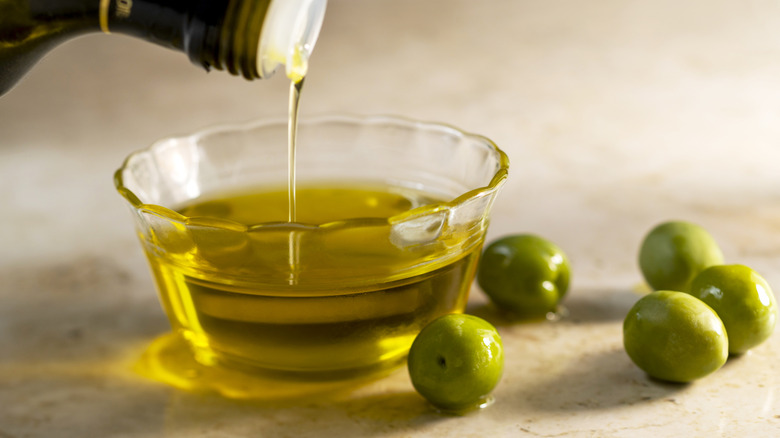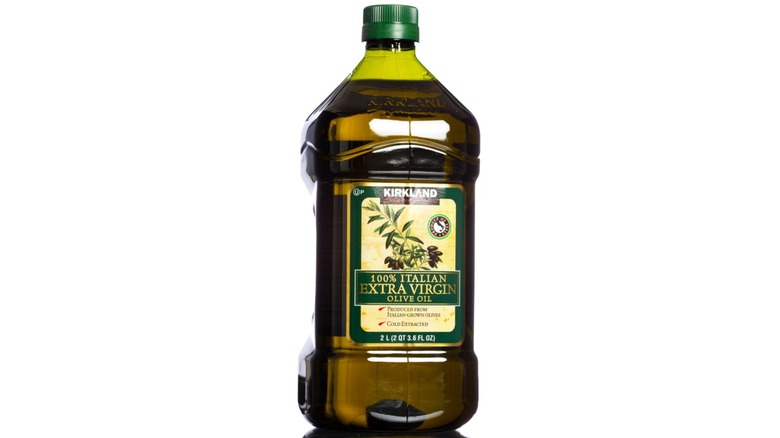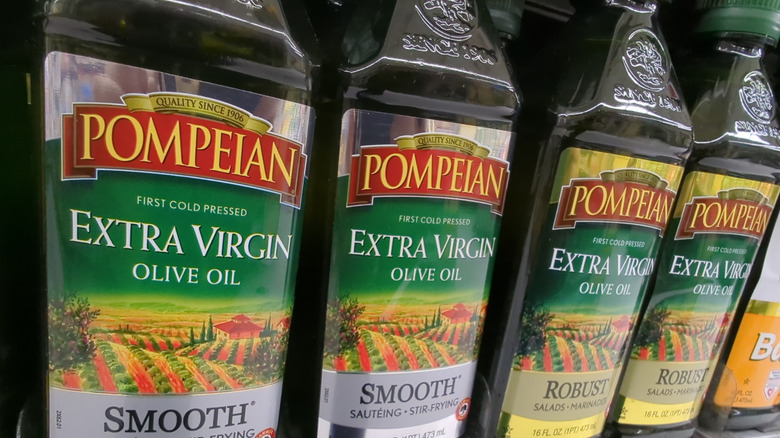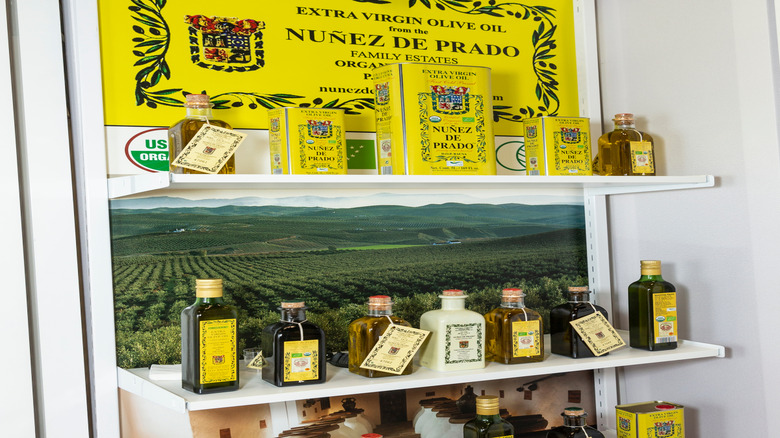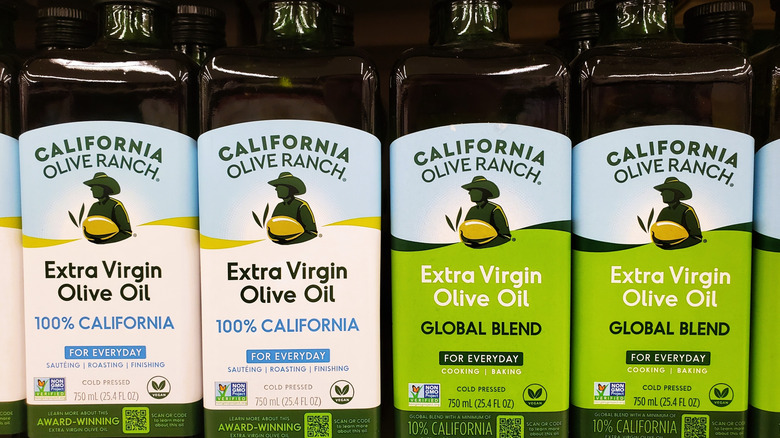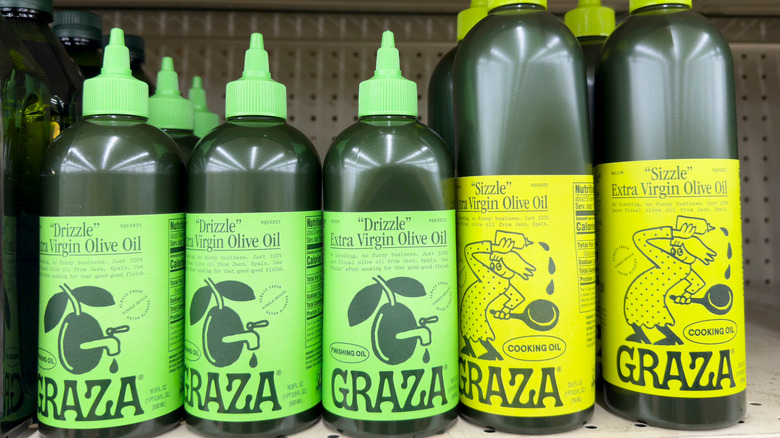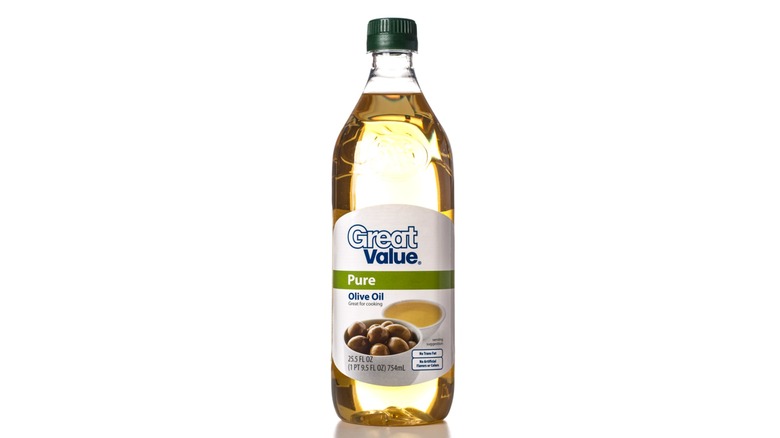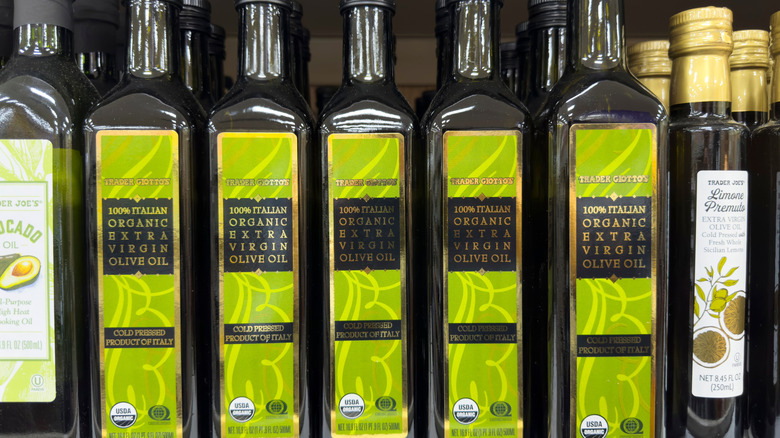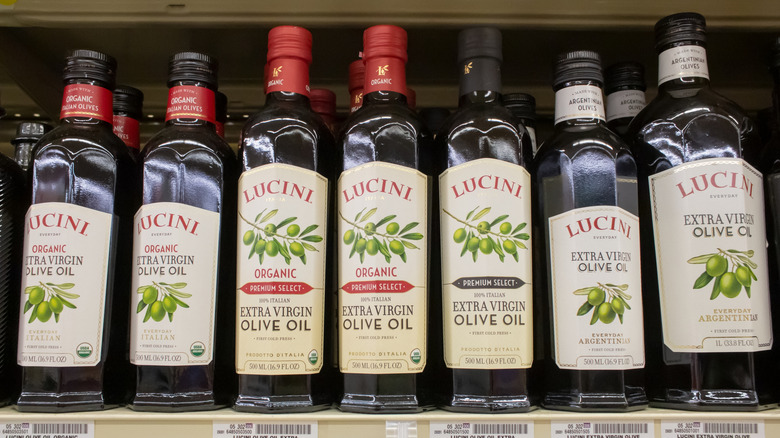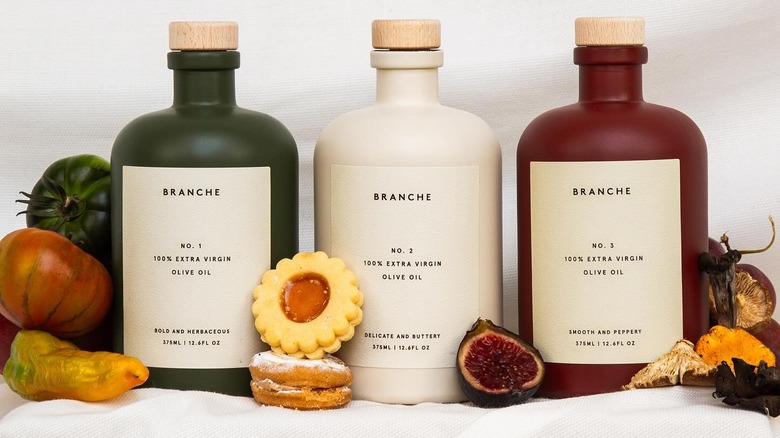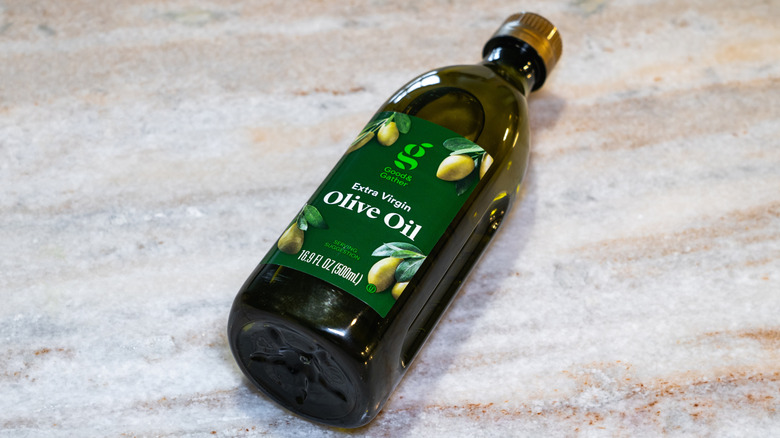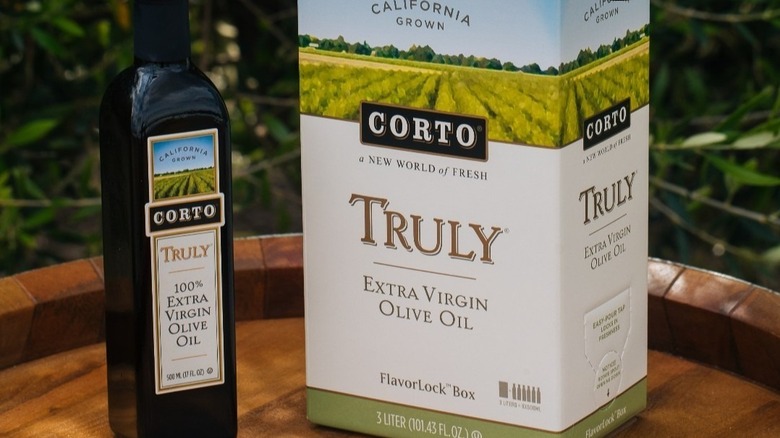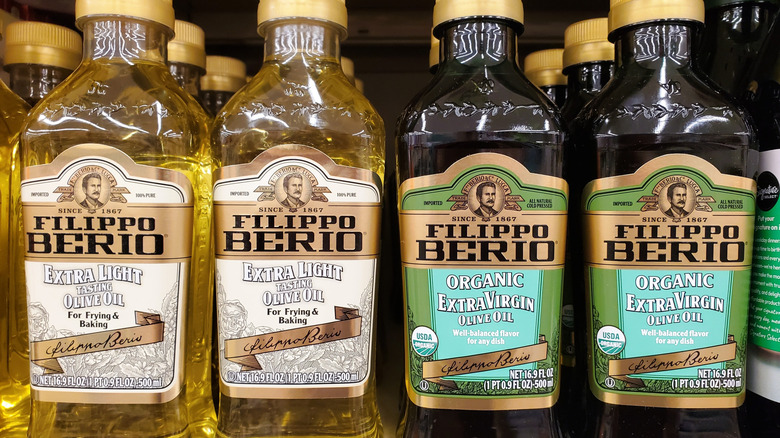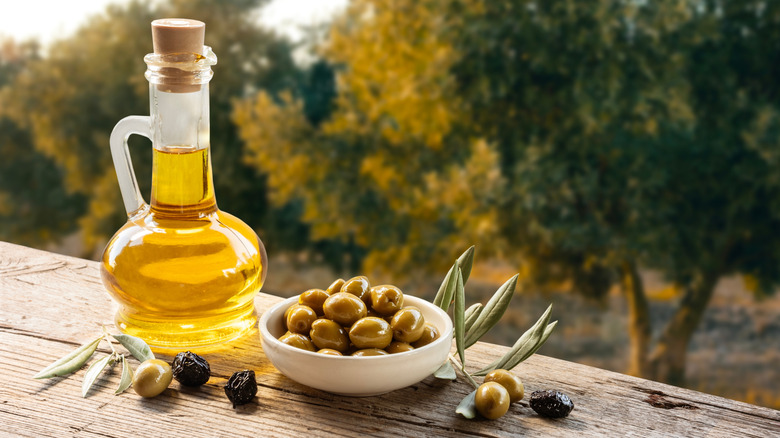The Best (And Worst) Olive Oil Brands, According To Reviews
In earlier version of this article reported incorrect information regarding mislabeling practices and lawsuits filed against Pompeian and Filippo Berio. This information has been corrected on 7/15/2025.
The abundance of olive oil varieties available is both a blessing and a curse. Sure, having options is nice, but there are quite a few flavorless duds lurking on the grocery shelves. These often boast promising labels with adjectives like "smooth," "robust," or "first cold pressed." Adding to the confusion are additional factors like harvest dates, source countries, and the fact that label fraud is a big issue in the olive oil industry. Unless you have the time and budget to sample dozens of olive oils, your safest bet is to listen to the reviews and stick with the most trustworthy brands. The truth about olive oil is that some brands dependably produce high-quality products while others are wildly inconsistent.
For our list of the best and worst, we've combed the web for professional write-ups, customer ratings, taste test results, and trending comments from threads and social media posts. We put the most weight on each brand's output of extra-virgin olive oil, which has higher production standards and thus better flavor than standard olive oil. Besides taste and texture, we also considered overall value and label transparency. Even a quality brand will taste rancid if it's too old, yet not all brands include harvest dates on labels. Without further ado, here's our list of what reviewers say are the best and worst olive oils currently on the market.
Best: Kirkland Signature
Kirkland Signature may be a private label, but Costco's "generic" line is famous for outdoing the national name brands. A top case in point is its selection of olive oils, which includes an extra-virgin organic and 100% Italian offering. The latter is pretty impressive considering most supermarket olive oils are blends from multiple countries. Single-origin labels are more than a marketing gimmick in the olive oil industry, and Kirkland's 100% Italian is indeed very flavorful and perfect for dipping and salad dressings. It even won a True Food TV blind taste test of budget olive oils.
However, other reviewers call out the organic as the top-ranked Kirkland olive oil. This one has a softer profile, making it a balanced option that's ideal for cooking. Even chefs have noted that it's a pleasantly light-flavored option that blends nicely without overpowering dishes. Kirkland Signature also scores points for value, with its EVOOs all costing under $15 a liter. However, it's best for households that go through a lot of olive oil, as Costco only sells these products by the 2-liter jugful.
Worst: Pompeian
Although Pompeian is a budget brand, it boasts impressive credentials as a farmer-owned company that has been producing olive oil for over a century. Many of its extra-virgin varieties even include a North American Olive Oil Association (NAOOA) certification for purity. Unfortunately, reviewers attest that none of these products stand out from the pack in terms of flavor. Common complaints about Pompeian are that it's bland, underwhelming, and lacks an olive taste.
Taste tests have also noted that its oils are often overly ripe, which is often the result of products sitting on the shelf too long. While premium brands usually help customers find the freshest bottles by printing their harvest dates, Pompeian only includes the less transparent "best by" date. Even if you cut Pompeian some slack for its budget pricing, the low quality and mediocre flavor make it onlya slight step up from vegetable oil.
Best: Nuñez de Prado
Having been harvesting olives in Spain since the late 1700s, the Nuñez de Prado family estate has its oil production method down pat. The brand claims the all-organic process involves bottling some of the unfiltered oil that flows naturally after crushing olives the "ancient" way — via granite stones — and before the first cold pressing. This technique requires 11 kilograms of olives to yield a liter of oil. Nuñez de Prado calls the final product "flower of the oil," reflecting the floral and citrus notes. You'll notice a more golden hue and flowery aroma the moment you pour from the bottle, according to customers.
Reviewers also say the fruity notes of lemon and apple create a unique flavor that's great for dressings and glazing veggies. Some have called out a touch of bitterness but in a good way. Slight bitterness is a sign of quality when it comes from the olive's natural antioxidants. Nuñez de Prado is a bit more expensive than lower-shelf supermarket options, but it's still cheaper than premium brands. You also get a nice dark bottle or tin (better for blocking out the light) and the harvest date on the label to ensure you're getting oil before it starts to degrade (ideally within 18 months of harvesting).
Worst: California Olive Ranch
California Olive Ranch has some wildly inconsistent customer ratings, scoring high on some taste tests and shockingly low on others. With single-origin EVOO grown exclusively in California, it's marketed and priced as a higher-quality supermarket brand. California Olive Ranch is also great at providing harvest date detailed oil info — each label features a QR code that lets buyers access the acidic and polyphenol levels of that specific bottle. You know you're getting true extra-virgin olive oil that's fresh and not blended with batches from various regions.
This should add up to a premium product with a distinct, rich flavor, and the brand does have its share of devoted followers. However, there are way too many poor ratings to recommend the brand at its current price point of over $15 for half a liter. California Olive Ranch landed dead last in our 2021 survey of the worst olive oil brands, with more than a quarter of respondents saying they disliked it the most. It also placed well below many lower-priced competitors in a blind taste test from America's Test Kitchen. Customers have complained about the brand having a plasticky aftertaste and a harsh, stale flavor. That could be due to California's erratic climate and the brand keeping its bottles on the shelf too long.
Best: Graza
While most premium olive oil brands embrace an ornate, Mediterranean vibe, Graza's products feature cartoon illustrations on squeeze bottles that look more suited for barbecue sauce. The playful branding and modern marketing approach have helped endear Graza to foodie influencers. But this mid-range olive oil wouldn't be flying off the shelves and into TikTok videos if it didn't have the quality to back it up.
The New York Times ranked Graza's "Sizzle" — the offering made for cooking — as its best all-around olive oil for 2025. Reviewers have commented on its delightfully grassy taste with hits of green apple and caramel. Even customers who have naysayed the brand's trendiness have conceded that it's a very good olive oil worth splurging on. Graza also sells a "Drizzle" EVOO that's punchier and better for adding to foods after cooking. Both of its products come from Picual olives sourced from a single Spanish farm. The difference is that the Sizzle olives get harvested a few months later when they're a bit more ripe, which makes them better to withstand high-heat cooking.
Graza mixes IG-cred with transparent harvesting practices that old-school cooks can appreciate. Sure, the plastic bottles aren't ideal for long-term shelf life and have been known to drip. But the squirt nozzle is surprisingly convenient for cooking.
Worst: Great Value (Walmart)
It's very tempting to grab a bottle of Great Value olive oil when you're budget shopping at Walmart. At around 40 cents per fluid ounce for EVOO, that's a pretty inexpensive gamble when you just need some cooking oil. For comparison, Graza's Sizzle costs more than 50 cents per fluid ounce at Walmart. However, that dime adds up to some big differences in quality between the two, according to reviews. Even Walmart's website includes numerous negative reviews, with some customers claiming that the product tastes rancid, ruins the food, and has a strange, cloudy appearance. It's especially important to steer clear of any Great Value olive oils that come in a clear bottle, as light exposure leads to much faster spoilage.
If you inspect a Great Value label, you're likely to find about seven origin countries listed, and different packaging countries from bottle to bottle. That means Walmart blends its oils from many suppliers, some of which could have questionable authenticity. You could get lucky and score a good batch from Great Value. However, consumer reviews say you're more likely to get a flavorless liquid that's more like sunflower oil or possibly rancid. It's because of products like these that many consumers have called Great Value the worst grocery store private label.
Best: Trader Joe's
Next time you browse a Trader Joe's for some hidden gems not sold at a traditional supermarket, consider stocking up on olive oil too. The quirky store known for its private labels has some of the best olive oils that won't break the bank. Trader Joe's has released numerous olive oil variations over the years, including limited-edition options such as the zesty Sicilian Selezione and aromatic Spanish Organic Garlic Flavored. Customers have particularly loved the 100% Greek Kalamata, which they've called spicy and complex. Reddit threads also include many positive comments on the Sicilian olive oil being particularly good for dipping.
The only problem with Trader Joe's is that these specialty oils tend to go fast when they're released. As for the regularly stocked standard varieties, reports have called out the 100% Italian Organic EVOO as a complex yet balanced single-origin option that's ideal for cooking. For a fruitier and smoother flavor that's ideal for drizzling, opt for the California extra-virgin olive oil. This option is completely sourced from the Golden State olives (otherwise, you can't legally put the state on the label) and features a pleasant grassy yet peppery flavor. Just be sure to stay away from the Trader Joe's Imported Olive Oil, which is clear, flavorless, and not entirely extra virgin.
Worst: Lucini
When it comes to olive oil, higher price tags don't always correlate to a better product. That's the issue with Lucini — it's priced like a premium product yet delivers some underwhelming quality. Founded in 1997, the brand claims it uses a traditional production method of milling small batches of hand-picked olives in local Italian mills. Lucini earned awards at international olive oil competitions in the mid-2010s before being acquired by California Olive Ranch in 2015.
Since then, the brand has received some pretty average reviews for being blandly mild and uninspiring. One Walmart reviewer called Lucini "elegantly mediocre" and suggested that the brand has recently gone downhill. A self-described olive oil connoisseur called Lucini just fine in one Reddit thread but added, "you can do much better than Lucini." The brand even came in last place in an America's Test Kitchen blind taste test, with reviewers knocking its harshness. Lucini packages its extra-virgin olive oil in a nice, darkened glass bottle with harvest dates and various production certifications on the label. It's exactly what you would expect from a bottle that sells for over $20. However, reviewers also expect a better flavor at that price point.
Best: Branche
If you're going to splurge on a truly premium-level olive oil, it better be good. Branche does not disappoint with its three offerings, all of which come from a single farm in Southern Spain. The boutique brand prioritizes quality at every level of production, from harvesting top-quality olives in small batches to packaging the oil within two hours of pressing to ensure freshness. Even Branche's bottles look amazing with their tapered glass and wood-stopper cap. However, the company is certainly about more than just aesthetics and appearing posh. Reviewers attest that the Branche lineup is worthy of the price tag — roughly $40 a bottle — and its "liquid gold" reputation.
All three of the brand's products are flavorful enough to work as finishing oils, but the No. 1 is the boldest option with the highest polyphenol level. It's a dipping sauce that can take bread to another level. The more buttery No. 2 blend is made for cooking, but customers say it's far from a basic oil to relegate to the frying pan. They say it has a slightly sweet character that's versatile enough that you can even use it as an ice cream topping. Branche developed its newest No. 3 release to be peppery with nutty undertones. Reviews for the brand are almost uniformly positive, with customers pointing out that all three varieties are distinct and add excellent flavor to dishes.
Worst: Good & Gather (Target)
While you can find some quality products from Target's Good & Gather line, olive oil is not one of them. Its bottles of extra-virgin olive oil generally sell for a very reasonable 41 cents or less per fluid ounce. But as reviewers have attested, you get what you pay for with this brand. Some consumers have expressed sneaking suspicions that Good & Gather's EVOO blend isn't truly extra virgin. Since the bottle, which comes in flimsy plastic with a cheap pour spout, does not carry certifications or a harvest date, it's tough to rule on the oil's purity.
Not surprisingly, customers say Good & Gather lacks flavor and is only worthy for basic frying. Use it for bread dipping at your own peril, as this oil tends to leave a bitter aftertaste. Even some reviewers on Target's own website get pretty snarky about Good & Gather, with some pointing out its unpleasant smell and "fake" flavor. Multiple customers commented that their bottles tasted rancid, with one claiming that it smelled of "car engine oil." Review's of the brand's organic variety aren't much better, with customers calling out no flavor improvement to justify the price increase.
Best: Corto
If you want an olive oil that's completely sourced in the U.S., it's tough to do better than a bottle of Corto. The family-run brand is devoted to maintaining freshness and quality throughout every stage of production at its Northern California farm. After picking the olives at just the right level of ripeness and running them through the cold press process, the oil undergoes a taste test and is stored in a climate-controlled cellar. Is all that hard work necessary to produce a delicious olive oil? Well, Corto's Truly Blend was strong enough to nab the No. 1 spot on the 2024 EVOO World Ranking's American olive oils.
Customers rave about Truly's ultra-smooth taste and rich character. It's not a bold olive oil that will storm your palate, but that's not necessary. Reviewers say the earthy, versatile blend is just as good in sweet cake mixes as it is on savory pastas. It's the kind of product that's just as popular with chefs as it is with discerning customers who appreciate a tasty olive oil. As a premium brand, Corto ships its oils with a card detailing which season's harvest each batch came from. The oil is a bit pricey, but you save significantly if you buy the 3-liter bulk size. This "FlavorLock Box" is specifically designed to block out light and extend the life of the oil.
Worst: Filippo Berio
The Italian merchant Filippo Berio began producing olive oil in the mid-1800s with the goal of supplying the finest cooks in his country. Now, more than a century later, his namesake brand is ubiquitous in supermarkets the world over. Unfortunately, reviewers have noted that the brand has sacrificed its artisanal Tuscan roots for bland mass production. A Chinese manufacturer now owns the company, and most of its olive oils are blended from imports outside of Italy.
A Reddit thread on Filippo Berio is rife with poor reviews bemoaning its forgettable flavor and questionable authenticity. Customers also note that it's woefully inadequate for dipping and has a surprisingly unpleasant aftertaste. However, some Walmart customers praise it for having a flavor that isn't overpowering. While the brand may be relatively affordable, but its oil may not be a hit with those looking for a deeper flavor profile.
Methodology
Comparing olive oil brands can be tricky as producers often tinker with various formulas and blends as climates and production costs change. That means an olive oil with the same label could taste different from one year to the next. Further complicating matters is the fact that some retailers handle products in better light conditions than others and may leave bottles available for customers too long after the olive harvest date. Such factors can sometimes undermine a usually good brand.
That's why we did our best to consider as many reviews as possible from both customers and professional critics over the past few years. That included taste tests, videos, Reddit threads, social media posts, reviews on store sites, and more. We factored overall taste first and foremost, with greater emphasis placed on each brand's extra-virgin olive oil products. Our best and worst verdicts also took into account price, value, production transparency, and packaging quality.
